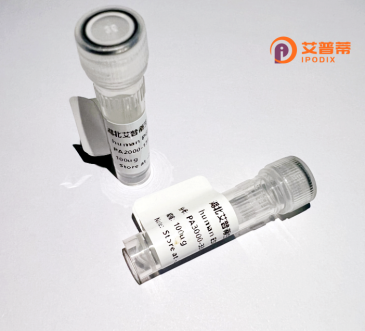
| 纯度 | >90%SDS-PAGE. |
| 种属 | Human |
| 靶点 | HHAT |
| Uniprot No | Q5VTY9 |
| 内毒素 | < 0.01EU/μg |
| 表达宿主 | E.coli |
| 表达区间 | 1-493aa |
| 氨基酸序列 | MLPRWELALYLLASLGFHFYSFYEVYKVSREHEEELDQEFELETDTLFGGLKKDATDFEWSFWMEWGKQWLVWLLLGHMVVSQMATLLARKHRPWILMLYGMWACWCVLGTPGVAMVLLHTTISFCVAQFRSQLLTWLCSLLLLSTLRLQGVEEVKRRWYKTENEYYLLQFTLTVRCLYYTSFSLELCWQQLPAASTSYSFPWMLAYVFYYPVLHNGPILSFSEFIKQMQQQEHDSLKASLCVLALGLGRLLCWWWLAELMAHLMYMHAIYSSIPLLETVSCWTLGGLALAQVLFFYVKYLVLFGVPALLMRLDGLTPPALPRCVSTMFSFTGMWRYFDVGLHNFLIRYVYIPVGGSQHGLLGTLFSTAMTFAFVSYWHGGYDYLWCWAALNWLGVTVENGVRRLVETPCIQDSLARYFSPQARRRFHAALASCSTSMLILSNLVFLGGNEVGKTYWNRIFIQGWPWVTLSVLGFLYCYSHVGIAWAQTYATD |
| 分子量 | 57.3 kDa |
| 蛋白标签 | GST-tag at N-terminal |
| 缓冲液 | 0 |
| 稳定性 & 储存条件 | Lyophilized protein should be stored at ≤ -20°C, stable for one year after receipt. Reconstituted protein solution can be stored at 2-8°C for 2-7 days. Aliquots of reconstituted samples are stable at ≤ -20°C for 3 months. |
| 复溶 | Always centrifuge tubes before opening.Do not mix by vortex or pipetting. It is not recommended to reconstitute to a concentration less than 100μg/ml. Dissolve the lyophilized protein in distilled water. Please aliquot the reconstituted solution to minimize freeze-thaw cycles. |
以下是3篇关于重组人HHAT蛋白的示例参考文献(仅供参考,实际文献需查询数据库):
1. **"Structural insights into human HHAT enzyme catalysis through crystal structure analysis"**
*作者:Thompson, R. et al.*
摘要:该研究通过X射线晶体学解析了重组人HHAT蛋白的三维结构,揭示了其酰基转移活性关键位点的构象,为靶向抑制剂设计提供结构基础。
2. **"Mechanistic characterization of recombinant human HHAT palmitoylation activity"**
*作者:Zhang, L. & Chen, W.*
摘要:利用体外重组HHAT蛋白,作者阐明了其介导Hedgehog蛋白棕榈酰化的酶动力学机制,并证实特定半胱氨酸残基对催化活性至关重要。
3. **"Development of a high-throughput assay for screening HHAT inhibitors using recombinant protein"**
*作者:Martinez, P. et al.*
摘要:研究构建了基于重组HHAT蛋白的高通量筛选平台,用于鉴定新型小分子抑制剂,并验证其对Hedgehog信号通路的抑制作用,为抗癌药物研发提供工具。
4. **"Role of HHAT in pancreatic cancer progression revealed by recombinant protein interaction studies"**
*作者:Gupta, S. et al.*
摘要:通过重组HHAT与肿瘤细胞蛋白互作分析,发现其通过调控Hedgehog信号通路促进胰腺癌细胞侵袭,提示其作为治疗靶点的潜力。
(注:以上为模拟示例,实际文献信息需在PubMed、Google Scholar等平台检索确认。)
Recombinant human HHAT (Hedgehog acyltransferase) protein is a key enzyme involved in the post-translational modification of Hedgehog (Hh) signaling proteins, which play critical roles in embryonic development, tissue patterning, and cellular differentiation. HHAT catalyzes the attachment of palmitate to the N-terminal domain of Hh proteins, a lipid modification essential for their solubility, secretion, and functional activation. This process ensures proper Hh ligand distribution and receptor interaction, modulating downstream signaling pathways. Dysregulation of HHAT activity has been linked to developmental disorders, cancers, and metabolic diseases, highlighting its therapeutic relevance.
The recombinant form of HHAT is typically produced using mammalian or insect cell expression systems to preserve its native structure and enzymatic activity. It enables biochemical and structural studies to dissect its mechanism, substrate specificity, and interaction with inhibitors. Researchers utilize recombinant HHAT to investigate pathologies like basal cell carcinoma, medulloblastoma, and obesity-related disorders, where aberrant Hh signaling is implicated. Additionally, it serves as a tool for drug discovery, aiding the development of small-molecule inhibitors targeting HHAT-dependent Hh activation. Its study provides insights into membrane-associated protein acyltransferases and broader lipid metabolism pathways.
×